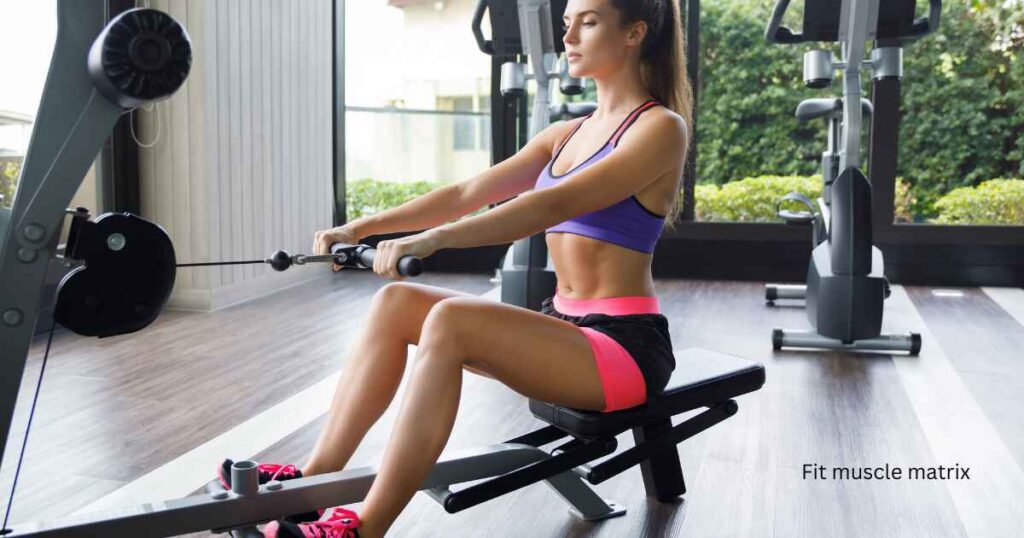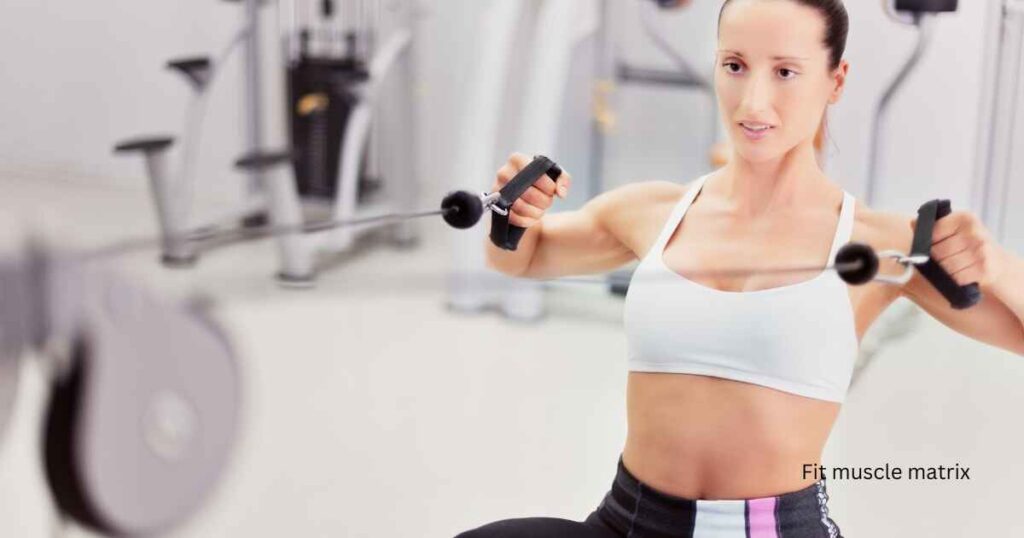Is a seated cable row enough for the back?: When performed without moving the shoulders (also known as non-retracted shoulder blades), seated rows have a greater impact on the middle trapezius and the rhomboid muscles than the last pulldowns. Seated row exercises are a great way to strengthen the upper back.
This exercise concentrates on the rhomboids and the lats. These are the two most powerful back muscles in the body.
It builds strength that can be translated into numerous other exercises like deadlifts and pullups. Building strength in our back muscles allows us to keep our posture in check and safeguard the spine.
Sit on the machine with your feet slightly wider than shoulder width. Then, drive the heels and then squeeze your glutes. Hold onto the handle of the cable. [Is a seated cable row enough for the back?]
7 different types of seated cable row moves are best for building back muscles
- Standard Seated Cable Row
- Wide Grip Seated Cable Row
- Neutral Grip Seated Cable Row
- Reverse Grip Seated Cable Row
- One-Arm Seated Cable Row (Single Arm)
- Rope Seated Cable Row
- Low Pulley Seated Cable Row
1. Standard Seated Cable Row
The Seated Cable Row primarily targets the lower back; the exercise also works your shoulders in some way, specifically those deltoids posteriorly.
This workout helps improve the extension of the shoulder and external rotation, which is an excellent exercise for shoulder strength and stability.
It is believed that the Seated Cable Row is one of the most effective exercises for strength training your back, and it must be part of your workout routine, but it is important to master it properly first.
These exercises help to build muscles in your upper. A strong upper body helps improve posture, safeguards shoulders, and reduces your chances of injury. [Is a seated cable row enough for the back?]

2. Wide Grip Seated Cable Row
A wide-grip cable row for seated use can be accomplished using a straight bar or a broad, neutral-grip handle. All of them can be used to improve the back’s width and size by putting the arms farther away from the body.
This seated line could be accomplished using different handles to change your grip and add a little emphasis on various back parts.
You can try a few seated-row options by swapping the handles on attachments.
The chest-supported row comes in a variety of types. Certain, such as seal row, for instance. The sealing row is an example of a liberated weight row you can do while sitting on the bench. It is important to pull the weight up. At an angle, you can also perform other tasks, such as the T-bar row. [Is a seated cable row enough for the back?]
Read Also: Should I eat before doing sit-ups?
3. Neutral Grip Seated Cable Row
A cable row is an excellent exercise to build the upper back muscles in a secure, stable, safe environment.
But if you’re a novice to exercises for resistance and cable machines, you’ll likely be looking at the exercise with a bit of nervousness.
Even if you’re a long way into weightlifting or bodybuilding, it’s important to understand how to perform the row. Since doing the exercise improperly can leave the risk of injuries.
As an accredited personal trainer, I regularly recommend rowing exercises for my customers. Here, I’ll outline the steps to perform a seated cable row and the most common mistakes to avoid. [Is a seated cable row enough for the back?]

4. Reverse Grip Seated Cable Row
These exercises help to build up muscles in your upper. Being strong in your upper body helps improve posture, safeguards shoulders and decreases the chance of injury.
Lay on the floor, legs placed with your back facing you. The knees should be bent slightly. Wrap the band on the soles of your feet.
Then, hold the ends with your palms facing towards the inside. You can brace your core. Take a deep breath and slowly stretch your arms, counting up to three.
Inhale and pull the band till your fingers are above your legs, with your elbows snugly in and your back straight. Hold for a moment. [Is a seated cable row enough for the back?]
Read Also: Can I make my calves slimmer?
5. One-Arm Seated Cable Row (Single Arm)
The single-arm cable row sitting in a seated position is an effective tool for separating your lats while increasing strength in your upper body.
A cable machine with unidirectional movement allows you to concentrate on every side of your back independently.
The single-arm cable row that sits in a seated position can be a game changer for separating your lats while also increasing the strength of your upper body.
Utilizing a cable machine that has single-handed movement can help you concentrate on each side of your back in a specific way. [Is a seated cable row enough for the back?]

6. Rope Seated Cable Row
The seated cable rows strengthen the muscles in the back and forearms. It’s a great all-round exercise to strengthen the back’s middle and provide beneficial arm exercises.
The seated cable row uses a horizontal cable-weighted machine, which includes a bench and footplates.
It can be an independent device or as part of an exercise facility with multiple gyms. Cable seated rows can be employed as part of an upper-body training session for strength.
For instance, in this set of exercises designed for beginners to weight-training enthusiasts, the seated cable row is a follow-up to the triceps pushdown and utilizes cables. [Is a seated cable row enough for the back?]
7. Low Pulley Seated Cable Row
Cable row can be a great exercise to build the upper back muscles in a secure, stable, safe environment.
If you’re a novice to the idea of resistance exercise and cable machines, it’s normal that you’ll be looking at the exercise with a bit of nervousness.
Even if your experience is in weightlifting or bodybuilding, it’s best to understand how to perform the row. Since doing the workout incorrectly puts you at risk of injuries.
As a certified personal trainer, I regularly recommend rowing exercises for my customers. In this article, I’ll explain exactly how to sit down and row and the most common mistakes to avoid. [Is a seated cable row enough for the back?]

Conclusion:
While seated cable rows are excellent for targeting the middle and upper back, they alone are insufficient for complete back development. To fully strengthen and build the entire back, including the lower back and lats, it’s important to combine seated cable rows with other exercises like pullups, deadlifts, and bent-over rows for a balanced and comprehensive workout. [Is a seated cable row enough for the back?]
Is a seated cable row enough for the back? FAQ
1. Can sitting cable rows on their own create a well-defined and strong back?
Cable rows that are seated can be great for building strength and muscles in the back’s middle region, especially the rhomboids, traps and lats. However, they are primarily focused on the pulling muscles in the horizontal direction and don’t fully involve the lower and upper back muscles as other workouts like deadlifts, pullups, and barbell rows. To get full exercise for the back, it’s best to mix seated cable rows with other moves that target different regions in the back.
2. Which muscles perform seated cable rows most often?
Cable seated rows focus on the upper and middle back muscles, including the rhomboids, the latissimus dorsi (lats) and trapezius (traps) and the rear deltoids. They also work those muscles of the bicep and the forearms in secondary muscles. In addition, your core muscles are engaged to help stabilize your body during the pull.
3. Do I need to mix seated cable rows with other exercises to get complete back exercise?
Yes, it’s advised to mix the seated cable row with exercises such as pullups and deadlifts, pulldowns on lats and barbell or dumbbell rows to focus on the whole back comprising those in the upper back (erector spine) and upper back in different planes of movement.
